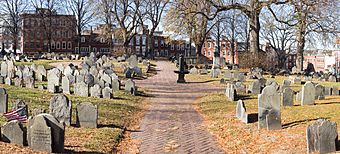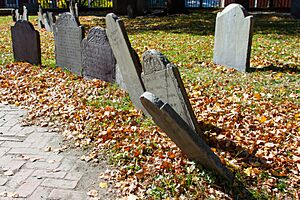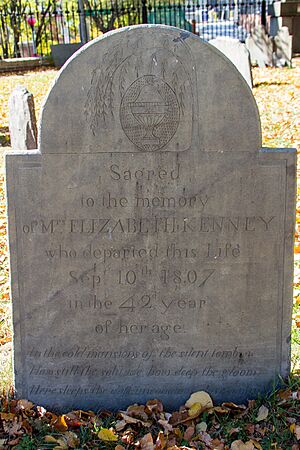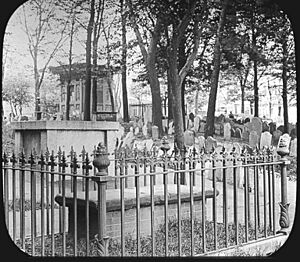Copp's Hill Burying Ground facts for kids
Quick facts for kids |
|
|
Copp's Hill Burying Ground
|
|
 |
|
| Location | Boston, Massachusetts |
|---|---|
| Area | 2 acres (0.81 ha) |
| Built | 1659 |
| NRHP reference No. | 74000385 |
| Added to NRHP | April 18, 1974 |
Copp's Hill Burying Ground is a very old cemetery in the North End part of Boston, Massachusetts. It was started in 1659. At first, it was called "North Burying Ground." This cemetery was the second one ever built in Boston.
History of Copp's Hill Burying Ground
The cemetery officially opened on February 20, 1659. The town bought land on Copp's Hill to create the "North Burying Ground." Today, it's known as Copp's Hill Burying Ground. It is the second oldest cemetery in Boston. The King's Chapel Burying Ground, started in 1630, is the oldest.
Copp's Hill Burying Ground has more than 1,200 marked graves. Many important people from Boston's early days are buried here. These include people from the colonial era up to the 1850s.
The cemetery grew over time. On January 7, 1708, the town bought more land. This land came from Judge Samuel Sewall and his wife Hannah. It was part of a field Hannah had inherited from her father.
Later, on December 18, 1809, Benjamin Weld and his wife Nabby sold more land. They sold it to the town for $10,000. Ten years after that, Charles Wells bought a small piece of land. Charles Wells later became the mayor of Boston. This land was also used as a cemetery. It was later joined with the North Burying Ground. Because of all these changes, it's hard to know exactly where the original cemetery boundaries were.
On the Snow Hill Street side of the cemetery, there are many unmarked graves. These belong to African Americans who lived in the "New Guinea" community nearby. Besides the graves, there are 272 tombs. Most of these tombs still have writing on them that you can read.
By 1840, fewer people were being buried here. The town still took care of the site sometimes. But by 1878, it was not well-maintained. When the Freedom Trail was created in 1951, this cemetery was not a stop. However, it has since been added. Many tourists and photographers visit it now. The cemetery was added to the National Register of Historic Places in 1974. This means it's recognized as an important historical site.
Famous People Buried Here
Many interesting people are buried at Copp's Hill Burying Ground:
- William Copp's children (the hill is named after William Copp)
- Shem Drowne: A metalworker who made the famous grasshopper weathervane on top of Faneuil Hall.
- Benjamin Edes: A journalist who helped stir up support for the American Revolution.
- Prince Hall: An important leader who worked to end slavery. He also started Black Freemasonry.
- Edmund Hartt: A master carpenter.
- Samuel Mather: A religious leader.
- Increase Mather: A very important Puritan minister and president of Harvard College.
- Cotton Mather: Another famous Puritan minister, son of Increase Mather.
- Robert Newman: One of two patriots who put signal lanterns in the Old North Church steeple. This was a signal for Paul Revere's famous midnight ride.
- John Norman: A publisher.
- Major Samuel Shaw: The first American consul (a government official) in Canton, China.
- Nicholas Upsall: A Puritan who later became a Quaker leader.
- Phyllis Wheatley: The first published African-American woman poet. She was formerly enslaved.
- George Worthylake: The first person to be the keeper of the Boston Light lighthouse.
Images for kids
-
From left to right, you can see the Skinny House, the Leonard P. Zakim Bunker Hill Memorial Bridge, and the Copp's Hill Burying Ground.
-
The Copp's Burying Ground in the front, with the Custom House Tower and One International Place buildings in the background.
-
Prince Hall's grave in Copp's Hill Cemetery.













